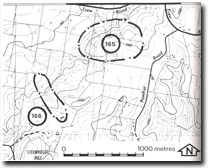165. Woolamai - Siliceous Sediments
|
This information has been developed from one or more of these publications:
|
| Location: | Dalyston – 712372. 1 km south-east of the Woolamai Race Track. | |
Access: | Trew Road and Pomfret Road. | |
Ownership: | Private land. | |
Geology/Geomorphology: | On the upper slopes of the Bass Fault scarp near Woolamai are outcrops and rock fragments that differ from the typical Mesozoic and Tertiary rocks of other parts of the Bass River catchment (Power 1971). They include feldspathic grits and a highly silicified sedimentary rock of uncertain origin. Power (1971) suggested the material may be derived from Palaeozoic rocks that had in part undergone weathering and conversion to silcrete. | |
Significance: | Regional. The silicified rocks are unusual in the Westernport catchment and their origin is uncertain. | |
Management: | Class 3. Changes in land use will not alter the significance of the features of the site. | |
References: | Power (1971). | |



